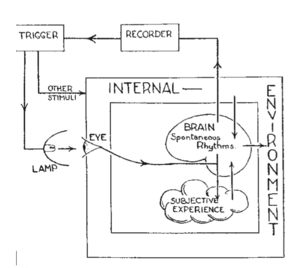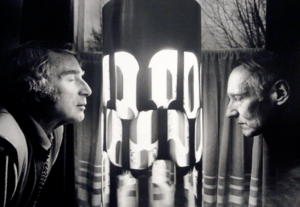User:Stonestone/secondessayfort2stone
Dreamachine -- To Create Space-Out
Introduction
Space-out is a feeling that people can never tell exactly what is by themselves which can be seen as the soul leaving the body. The views that people see in front of them when their minds escape from their bodies, are diverse and different from the others and difficult to tell clearly. However, the trigger points of space-out are quite similar, drugs, alcohol even some specific visuals, for example. Dreamachine, as one of the most critical patent of triggering space-out, also known as a piece of art work, is a good example to explore the phenomenon of space-out. In this essay, I will give my research on how dreamachine make efforts on people and why people get the feeling of space-out.
Flicker
“Flicker” is a long-standing term of art in experimental psychology, referring to visual effects induced by flickering lights. In 1945, Dr. W. Grey Walter applied flicker into his EEG research, in the end an electronic stroboscope was invented. After an experiment in a big range of people, Dr Walt got the feedbacks (strange feelings) from samples he chose, which were:" faintness or swimming in the head"; "unresponsive or unconscious for a few moments"; "the limbs jerked in rhythm with the flashes of light."
As shown in the diagram on the right, eyes receive the lights from the strobes (lamp) as an subjective experienced signal which is transmitted to our brain, then, the signal (brainwave) goes through the recorder make efforts on the trigger.This loop can be seen as the basic prototype of how the visual flicker we look at works on our brain.
" We all noticed a peculiar effect . . . a vivid illusion of moving patterns whenever one closed one’s eyes and allowed the flicker to shine through the eyelids. The illusion . . . takes a variety of forms. Usually it is a sort of pulsating check or mosaic, often in bright colours. At certain frequencies—around 10 per second—some subjects see whirling spirals, whirlpools, explosions, Catherine wheels. "
Dr Walter noted after experimented with strobes on himself.
Cybernetics(on going)
As a basic question of cybernetics: "how people's brain thinks" can be noted here. There is no doubt that modern consciousness is more and more affected by technology as the modernity
However, those illusions are similar to the hallucinogenic effects of psychoactive drugs such as LSD and mescaline, which is one of the most important reason why it becomes popular in 1960s and led to the invention of dreamachine.
From Dr Walt to Brion Gysin
Dreamachine(on going)
In the post-World War II era, the Beat Generation rediscovered the drug-like strobe-machine by reading Dr Walt's book The Living Brain. It starts with an experience of Brion Gysin, a painter, writer, sound poet, and performance artist born in Taplow, Buckinghamshire. In his dairy he wrote:" Had a transcendental storm of colour visions today in the bus going to Marseilles. We ran through a long avenue of trees and I closed my eyes against the setting sun. An overwhelming flood of intensely bright colors exploded behind my eyelids: a multidimensional kaleidoscope whirling out through space. I was swept out of time. I was out in a world of infinite number. The vision stopped abruptly as we left the trees. Was that a vision? What happened to me? "
After reading Dr Walt's book The Living Brain which was lent by William S. Burroughs, Gysin had found the answer. That is also the critical point of the relationship establishing between Flicker and Dreamachine; Walt and Gysin. Afterwards, Gysin built the Dreamachine in the early 1960's by putting a cylinder with holes onto a record player turn tablewith a 100 watt lightbulb in the middle. When the record player being set to spin at 78 round per minute, the strobes turns into the visual of sitting in a bus and passing shades of leaves under the sun, which makes the light flickers at a frequency of about 20Hz Alpha brainwaves which are associated with subconsciousness.
With bringing the changes of brainwaves to people, dreamachine is displayed as an art piece in by Brion
Space-out
Brainwaves
Brainwaves has been mentioned earlier, which plays an important role in space-out experience. The blinky lights made by dreamachine produce about 20 hz brainwaves in our brain, in a way, it is within or close to the range of alpha wave( in a range around 8 -13 Hz ), which will bring people the feeling of deep relaxation, vice versa. Besides alpha wave, there is also Beta wave, Theta wave and Gamma wave which show or make different efforts on our brain. .
Nosebleed - From Walt to Brion
Dreamachine, as the most important reference of my project "Nosebleed" gives me a chance to create the space-out experience in my work.
For the first attempt, I downloaded an alpha wave meditation video on youtube, and put the sound into a program I made (http://pzwart1.wdka.hro.nl/~ying/404/thatwave.html) using Web Audio API. This program is able to calculate the data of the sound and then, visualize the data into different colours in order to bring the blinks by colour fast changing.
It did results in something blinky, but the question is: if it is the real alpha wave frequency. As a matter of fact, people can only actually hear the sound between the range of 20Hz to 20000Hz frequency by ears, so there is no one can hear an alpha wave sound. When I thought I should give up the idea of creating alpha wave blink because the alpha wave audio is a fraud, I found the origin of the special sound in the youtube clip - "Binaural Beats".
"A binaural beat is an auditory illusion perceived when two different pure-tone sine waves, both with frequencies lower than 1500 Hz, with less than a 40 Hz difference between them, are presented to a listener dichotically, that is one through each ear. For example, if a 530 Hz pure tone is presented to a subject's right ear, while a 520 Hz pure tone is presented to the subject's left ear, the listener will perceive the auditory illusion of a third tone, in addition to the two pure-tones presented to each ear. The third sound is called a binaural beat, and in this example would have a perceived pitch correlating to a frequency of 10 Hz, that being the difference between the 530 Hz and 520 Hz pure tones presented to each ear." -- Wikipedia
It gives me a new perspective of collecting alpha wave data -- using Third Tone pitch frequency. The frequency is from 7 Hz to 12.9 Hz which is right in the range of alpha wave.
Conclusion
Reference
Nic Sheehan, Flicker, 1997, Documentary, 1:12:02
B.C. ter Meulen D. Tavy B.C. Jacobs, From Stroboscope to Dream Machine: A History of Flicker-Induced Hallucinations, Eur Neurol 2009 pp316–320
Thomas Budzynski, Ph. D., The Clinical Guide to Sound and Light, 2006
David Siever The Application of Audio-Visual Entrainment for the Treatment of Seniors 2004
Luciana Haill ICT & Art Connect : Revelations by Flicker, Dreamachines and Electroencephalographic Signals in Art
http://www.permuted.org.uk/Flickers.htm
http://www.slideshare.net/holcombea/uws-june2013for-slideshare
http://briongysin.com/



